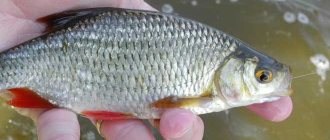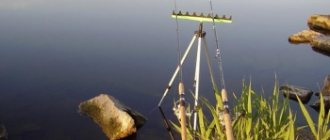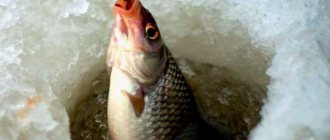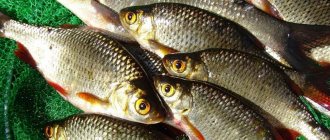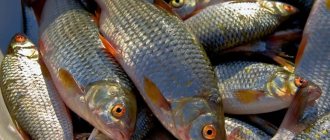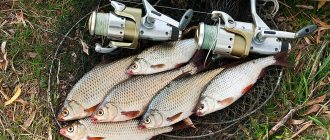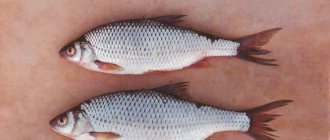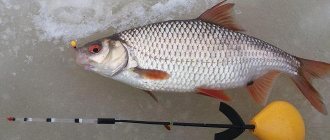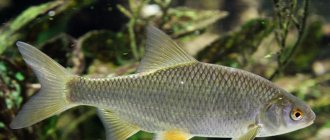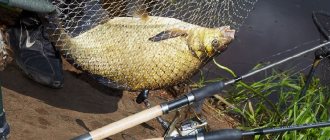Nikolay Linnik, Mozyr | June 24, 2021
The popularity of the English bottom fishing rod (feeder) is currently growing like an avalanche. Our fishermen love this tackle: for its ease of use, for the comfort with which you can sit on the shore, and for its catchability.
But, I assure you, the feeder is not a panacea. Like any other gear, it has periods when the angler’s expectations are very different from the actual catches. One of these periods occurs at the beginning of summer. People say: “June has come, don’t spit on fish.” I partially agree with this. The post-spawning feast has already passed for most fish, and food is abundant in the coastal zone. If you want the fish to hang itself on the hooks, then it’s really better to wait for a more favorable time.
Knowing this, many anglers simply switch to float gear and fish with them until July, when numerous river spits dry out, the fish move closer to the fairway - and the efficiency of the feeder becomes high again. But if you approach the process creatively and are ready to quickly respond to changes occurring in the river, fishing with bottom gear in June can turn out to be very interesting.
The biggest challenge in catching well-fed and capricious fish is determining exactly which tactics will work most effectively. It is almost impossible to play on the feeling of hunger. If you use standard bait based on dry mixtures and cereals, then most likely it will collect the ubiquitous small things. Trying to offer the fish some kind of exotic bait is also a very risky idea (a well-fed fish is unlikely to want to chase food unknown to it). All that remains is to try experimenting with the presentation of the bait. And it is best to do this with food that is well known to the fish. The situation is significantly complicated by the presence of a large amount of grass near the shore and at the bottom of the river. So the right choice of gear is one of the key points of successful fishing at this time of year.
Feeder or picker?
In June, looking for fish on the fairway is a waste of time. They all live near the shore. A large fish, experienced and sophisticated, never forgets about its safety - and therefore any unnecessary noise, be it a ball of bait falling into the water or a feeder splashing on the water, can alert it. And the presentation of the bait for large fish should be as natural as possible. For the conditions of shallow water overgrown with grass, a feeder tackle is too coarse, and it is unlikely to be possible to present the bait correctly with it. I prefer to use a lighter option - rods with a weight of up to 50 g. Using such tackle, you can very delicately deliver the bait to a distance of 15 - 20 m from the shore and bring out large fish, using even a very thin leash.
Long (3 – 3.3 m) picker rods with a complex action are best suited for catching large fish in the current. I fish with an Allux Pride Master Class 330 cm rod with a test weight of up to 50 g ( photo 1 ), it is made of the same material as the more expensive Sportex , but in terms of performance it even surpasses them in some ways. For me this is the ideal option. With light loads, the rod is very rigid, so casting the bait is very accurate. But when fishing for fish, when almost the entire form is involved in the work, the rod very successfully absorbs jerks and does not leave the slightest chance for the opponent. Even if you have to use the thinnest leashes.
Pickerel fishing technique
The search for fish sites begins from the points farthest from the shore. If there are no bites, then some time after casting the equipment is slowly pulled closer to the shore - 2-3 turns with the inertia-free handle and a pause of a couple of minutes. And in this way they lead the rig to the shore. Two or three such wiring is enough to understand whether there is fish in the fishing area. If there is no bite, then it is advisable to change the place. Bites usually occur at the initial stage of the bait's movement after a pause. Then it is advisable to make casts to the bite point, although sometimes the fish is wary, then they use a cunning technique: they cast a little further, then pull the tackle a little at a time to the bite point. And with all these maneuvers, the rod length of 2.7 m is quite enough. Although it depends on whom. For example, it’s not enough for me - I fell in love with long, light rods, having spent many years fishing with short ones. The feeling of working with a light, slender “four” (especially of greater length) is indescribable! Only at first the shaft seemed uncontrollable, but after the first fishing I became friends with it. How to convey these feelings? Don't even know. You can probably compare it to a car. Small - nimble, maneuverable, you can park in any hole, a little cheaper, but something is not right about it, it wanders at speed, you need to constantly steer, you get tired on a long journey. A big car is different, a little clumsy in the urban jungle, but with dexterity it seems to be ok. And you jump out onto the track, and you enjoy the control - it rushes at any speed like a locomotive on rails, obedient, cozy, roomy, maybe you don’t need such a big one, on the other hand, a lot is not a little, let it be.
It’s the same story with a feeder rod – 4 m is not always necessary, but it often helps out
On the river, it more successfully fights against the “blowing out” of the equipment by the stream, keeping a significant part of the fishing line above the water. When there is tall grass behind you, it is more comfortable to cast with a long rod. In places where the bottom is fairly uprooted or overgrown with aquatic vegetation, it is easier to lift the feeder with a jerk, avoiding an offensive snag. With a long rod it’s easier to make sweeping hooks, and it’s easier to pick up the slack in the vein when casting long distances. In addition, with the help of such a rod the fish gets tired faster, with such a form the maximum load on the leader is more clearly felt, it is easier to tear the trophy off the bottom without letting it into thick grass or snags. In addition, I made sure that long fishing rods were cast further, finishing off fish that did not want to approach the shore.
At the same time, long bottom fishing rods have their own disadvantages: they are difficult to control in cramped coastal conditions, they are not very convenient when fishing from a boat, and they are not easy to maneuver during the most important fateful stages of fishing. Only short rods (up to 3 m) retain acceptable action when using material with a high fiberglass content, at least they do not sag under their own weight. Although the structure of a bottom rod is a rather relative concept. The vast majority of light and medium class blanks have a parabolic action - under load they work almost their entire length. This is not a drawback, but a vital necessity - you need to throw the feeder further away and work well in the process of fishing, securing the thin leash. And whoever doesn’t like the “parabolic” rod, instead of a bottom rod, uses a fast spinning rod in the area of 2.7-3 m with a soft tip and a dough of up to 30-50 g, depending on the weight of the feeders used. In specialized bottom fishing rods, the “standard” has recently taken root en masse - inexpensive composite feeder fishing rods with a length of 2.7-3.3 m, these are the ones that take away most of the advantages of both long and short fishing rods (on some forms the length is indicated in English feet - 1 foot is equal to 30.48 cm) . In any case, to successfully select a fishing rod, it is important to turn off the stereotypes driven in by brand advertising, because one of the most important selection criteria is how the angler feels, whether it is easy in the hand or not.
Fishing on a feeder
Simple and reliable feeder
Reels
For a very long time I used exclusively Shimano reels, so I was not very willing to switch to the new Allux Ruthenium Match with a front brake ( photo 2 ). But I must say that I was pleasantly surprised. The mechanism of these reels may not be as smooth as that of Shimano , but overall my impressions are only positive. The line is laid on the spool evenly and neatly. The reel body has serious protection against moisture; this reel is not afraid of even short-term swims.
And due to the perforated rotor, this reel turned out to be very light, and does not at all upset the balance of the elegant picker tackle. Another pleasant surprise for me was the flawless operation of the friction brake. It is adjusted so softly that even with a leash 0.1 mm thick, I was able to bring out kilogram ides and podusts ( photo 3 ), the bite of which is not uncommon at this time.
Equipment
On pickerel I still prefer to use only monofilament lines. The casting distance of this tackle is short, about twenty turns of the reel, and there is no need to worry that the stretchability of the monofilament line may negatively affect the casting accuracy. As the main line, I most often use Browning Cenex Plummet Method Feeder Line with a breaking load of 3.7 kg ( photo 4 ). It is no coincidence that I choose such a small fishing line diameter (0.2 mm).
When fishing with such delicate gear as pickerel, it is very important to maintain maximum precision in feeding. The water puts much less pressure on a thin fishing line, which means the equipment slides less along the bottom. But you also don’t need to get carried away with too thin fishing lines. Firstly, from time to time you have to deal with large and strong fish. And secondly, in the coastal zone of the river there is always a lot of bottom debris. The main danger to the equipment is shells. When rubbing against their sharp edges, scratches will certainly form on the surface of the fishing line. And the thinner the fishing line, the more dangerous these “wounds” are for it. So a diameter of 0.18 - 0.2 mm is the golden mean.
Choosing a place to catch spring roach
In order to catch roach with a pickerel, in addition to the right gear, you need to choose the right place. Although the roach has already begun to emerge from hibernation, it is still careful and prefers delicacy. Let's look at where to catch roach in the spring.
Roaches often occupy the deepest parts of a reservoir. It is attracted here by both favorable temperature conditions and a small current that washes away bottom food.
As the weather warms, roaches migrate to relatively shallow water areas. But even here, finding a fishing spot is not easy. It very rarely happens that a place chosen at random brings a good catch.
Therefore, to catch spring roach, you should choose a place near:
– shell edges; – braid; – shallows; – treatment facilities where the fish will look for food.
It is easiest to catch roaches in the spring in the places listed above. But you cannot take this information as dogma - the roach moves a lot, so you need to look for it. Help in the search can be provided by local fishermen, concentrations of which are observed in roach migration areas. The spring movement of roach takes place along the same routes every year, so the information received will be relevant for the next year.
Read more about catching roach in spring.
Installation of equipment
The main advantage of picker lies in its delicacy. Therefore, the installation of equipment should be as delicate as possible. After going through many options, I chose the so-called in-line installation. A clip with a built-in fastener for attaching the feeder moves freely along the main line. At the bottom, the travel of the clip is limited by a silicone float stopper ( photo 5 ). Below this stopper there is either a twist from the main fishing line about 8 cm long, or a piece of feeder wire of the same length.
I like the feeder-gum installation better: the presence of an elastic insert gives me additional advantages when fishing for large fish. A leash with a length of 30 to 60 cm is attached using the “loop to loop” method. As you can see, installation is very simple and there is practically no confusion. I select the diameter of the fishing line for the leash based on fishing conditions, but usually it does not exceed 0.12 mm.
Picker fishing with a feeder
When exposed to waves, wind, or surface currents, a fly or match fishing rod does not hold the equipment in place well, which negatively affects the bite. In such cases, the best tackle is a pickerel. To increase catchability, it is useful to equip the picker with a small feeder, and one that can collect fish, giving out animal food in a special way...
When the fishing rod stops working
Currents, wind and waves are the main obstacles for a fishing rod. Fish often don't want to chase bait that drags or swims away. In order not to be left without a catch, in such cases the equipment has to be anchored with a heavy load and a heavier, stable float is installed. At the same time, the information content of the gear is sharply reduced.
All this has a particularly negative effect in cool water in spring and autumn, when the fish prefers to stand and make the most delicate bites, and also does not want to pay attention to the moving bait. Experience shows that a pickerel with a feeder at distances of 15 - 30 meters turns out to be the best tackle in such conditions. But at the same time, it is advisable to use, along with a regular mesh feeder for plant food, a special feeder with a closing loading window for maggots. What does this give and how to properly use a picker with a feeder - more...
Why a special feeder on the picker?
The main advantage of the picker is its noiselessness and the ability to catch cautious fish in shallow waters. A large feeder, with its own food, is not always useful, since in quiet places, for not very active fish, it acts like a scarecrow, slowing down activity, or even driving out the school. The small feeder makes an order of magnitude less noise and can release maggots both at the bottom and during the dive, if the lid is not closed. Then we get slowly sinking animal food, which significantly activates the fish.
How to fish with a pickerel with a feeder
Tactic options depend on conditions. In most cases, a mesh feeder is first installed under plant food, with the help of which a cloudy cloud is created within half an hour, which attracts and activates fish. Fine dusty bait is used, while it is useful to place a little bloodworms and maggots in the center of the feeder.
After half an hour of dusting, it is advisable to install a feeder under the maggot and send it to the casting point in small portions. At the same time, ensuring the escape of some of the larvae at the submersion stage. This significantly provokes the fish to become active.
Picker fishing options in different conditions
- The tactics described above using preliminary dust feeding are best suited when the fish in cool water are inactive and are at half-water. This often happens with bream, crucian carp and roach... and can last more than a day or even weeks, when it is extremely difficult to stir the fish. This option can also be considered as a universal one.
- For fishing in very cold water, it is better to immediately use only animal food in minimal quantities. Add plant-pulverized food to a minimum as an experiment.
- For summer fishing on the river, when the fish are active, use larger feeders and do not skimp too much on animal feed. Abundant feeding in such conditions will not hurt.
Tackle and accessories
A picker rod with a test weight of 35 - 45 grams and a length of about 2.5 meters is excellent for both small loads and feeding with a feeder.
The match reel (you can also supply it) is equipped with a monofilament line with a diameter of 0.18 - 0.2 mm.
Regular parthenoster provides sufficient information content. A mesh feeder with its own weight of 10 - 20 grams is quite sufficient for confident casting. For maggots - with the same weight, with a load in front, for accurate casting.
The leash is connected to the rig in a loop-to-loop fashion.
But it is recommended to make a special leash, designed for slow immersion of the nozzle.
Leash with hook
You can use a regular leash made of fishing line with a diameter of 0.12 mm and a hook No. 18 if the fish is active and a mesh feeder is used for dusty food.
With a picker feeder for maggots, a slowly sinking leash gives good results. Its length is 50 - 60 cm, and its diameter is 0.18 mm. The large diameter of the line provides the necessary windage for slowly lowering the bait with an imitation of free diving.
In addition, a thick leash is much less likely to tangle. At the end of the leash, a fluorocarbon thread 7–8 cm long and 0.14 mm in diameter is tied, which provides the necessary invisibility of the gear. To connect the fishing line to the fluorocarbon, a regular double knot (weaving) is used.
What to consider
- The main line is pre-wetted with dishwashing detergent. Then it will sink better, there will be fewer problems with wind, waves and currents, and there will be no missed quick bites in the falling phase.
- The tip is selected according to the conditions, usually 0.5 oz gives the necessary information content, but in windy weather 0.75 oz is possible. The feeder is also selected, usually within the range of 12 - 20 grams.
- The more accurate the casts, the more bites. In addition to the obligatory clip on the reel, which maintains the distance, a landmark on the shore is selected to which the casts are made. A marker mark on the line will help clarify the distance.
Feeding
Fishing with a pickerel with a feeder begins with the creation of finely dispersed food. Conventional feeder bait can be diluted with ground rye breadcrumbs and sunflower cake in equal proportions. The bait is ground through a sieve and then gently moistened a little. The degree of moisture is approximately such that the food can be formed into a ball only with significant compression by hand. At the first stage of fishing (feeding the point), a small mesh feeder is used, inside which ordinary plant bait and a small amount of caster, maggots, and bloodworms are placed.
How to use a picker with a feeder
The usual practice is that, having created a bait spot with precise casts, it is advisable to switch to a quieter feeder of small mass, designed to deliver maggots. As a rule, the fish respond positively to this approach and the first rare bites turn into a decent bite. The pace of fishing gradually increases, as the falling and slowly sinking maggots create a stir within the school. It would be appropriate to use a slowly sinking leash.
With a picker equipped with a maggot feeder, you need to respond to lightning-fast bites during the immersion phase of the bait.
- Cast in such a way that the line is limited by the clip and the leash straightens in flight.
- After casting, you need to immediately sink the line, lower the tip of the rod under the water and make a short jerk.
- While immersing the feeder, 1 - 2 seconds before touching the bottom, it is advisable to tighten the rig half a turn with the reel handle so that in the final phase of immersion the leash straightens and becomes informative.
- After installing the rod on the stand, it is advisable that the butt be under your hands (in your hands) for a timely response to a quick bite.
- When the fishing pace increases, you can leave the maggot loading window open so that most of it escapes from the feeder during the submergence phase. This further increases the likelihood of quick bites. But at the same time, it can lift the fish up, and after a while bites will become more rare. In this case, it is enough to fish as standard again, and the fish will sink to the bottom...
Multi-component bait
You don’t have to be too zealous when choosing plant bait in June. The smell of bait is secondary. It is much more important to correctly adjust its mechanical properties. When fishing with pickerel on grassy river shallows, plant bait performs only a transport function to deliver animal components to the fishing point. Through trial and error, I chose coarse mixtures that quickly disintegrate in water ( photo 8 ).
For 1 kg of bait, which needs to be pre-soaked and sifted through a sieve several times, I usually use 0.2 liters of sinking casters and the same amount of floating casters ( photo 9 ). The use of casters instead of maggots in bait is not accidental. Unlike maggots, light casters quickly separate from the bait, rise on top of the grass and attract fish that are located downstream. While sinking casters lie in a compact heap in the area of the stern “spot”.
Bait with casters is used at the initial stage of fishing. Therefore, it is not necessary to prepare it in large quantities. Of course, you can continue to feed casters further. But in order to cut off small fish, which will certainly be the first to gather in the feeding zone, after a while I prefer to switch to feeding with clean maggots. To do this, instead of a cage, a special maggot feeder is hung on a fishing line.
The pace of fishing with such a feeder slows down significantly, but this is exactly what is needed: the fish will begin to collect maggots crawling out of the feeder, and, therefore, will constantly be close to the hook with the bait.
Picker equipment
Correctly selected equipment when fishing with pickerel ensures almost half of the success. After all, the overall sensitivity of the gear, the effectiveness of bites and their implementation depend on the equipment used.
The choice of equipment for fishing with a picker is the same as for traditional feeder fishing, except that the fasteners and swivels are chosen to be smaller for greater sensitivity and ease.
An unsurpassed favorite among rigs for pickerel fishing is the paternoster. It is very simple, virtually tangle-free and sensitive enough to catch even small fish. The Gardner Paternoster is the most versatile equipment that will not let you down in any fishing conditions.
Another feature of this type of equipment is the possibility of manufacturing without the use of accessories (swivels, fasteners, etc.), and this is an undeniable plus for achieving maximum sensitivity of the equipment.
The equipment is selected depending on the fishing conditions and the mood of the fish; The fisherman’s preferences and skills also play a significant role in this. Hooks are selected for specific fishing depending on the size and type of bait and the intended fish.
Lures
Since at the initial stage of fishing, bait is mainly carried out by casters, they will look most advantageous as bait. Floating casters are very fragile and must be handled with great care. The casters are placed on the hook by the upper part so that the hook penetrates the pupa from both sides. And in order for the bites to be clearer, I recommend adding younger sinking pupae to the floating casters. First, one sinking caster is attached to the hook, then one ( photo 10 ) or several floating ones.
Bait presentation options
Now we have reached the moment when the advantages of a picker over a heavier feeder become obvious. You cannot do without proper presentation of the bait when catching large fish. And the feeder is too static a tackle that does not allow any significant experiments with presentation. Yes, you can change the weight of the feeder, the length of the leash, and the installation diagram. But the lower limit at which the tackle loses its sensitivity is still too high for the feeder. But with a picker, if necessary, you can put a 10-gram feeder, and then a sinker of the same weight or even lighter.
In general, I experiment with bait presentation on every fishing trip, regardless of whether I’m fishing in a place I know well or have come to a new one. After all, something is constantly changing in the river, and this forces the fish to behave differently. It is very useful to change the type of presentation after each catch of a large fish, change the bait on the hook, or simply every half hour of fishing. Picker allows such experiments to be carried out without any problems. And the result can be a stable bite of “bonus” fish. Have fun fishing!
Picker feeders
For pickerel fishing, feeders of small volume and light weight are used. But even within the picker limits, the parameters and type must correspond to the specific fishing conditions and the type of intended fish.
Read! Fishing on the rink in the summer. What is rolling tackle?
Let’s assume that the main purpose of fishing is bleak or small roach that feed in the water column. In this case, it is worth choosing open-type feeders (mesh) of small mass and preferably plastic. When such feeders are immersed in water, a trail of bait will be created, which will attract fish and force them to sink to the bottom towards the bait table.
The situation is completely different when fishing for bream, carp or any other fish that feeds from the bottom. In this case, closed feeders of greater mass than in the first example are appropriate. On the way to the bottom, they will “lose” a minimum of food and almost all of it will be delivered to the feeding table. At the same time, small fish are minimally attracted to the fishing point, therefore, more respectable specimens can be caught.
When choosing feeders, you should take into account the fishing conditions: depth, presence and strength of current. The principles for choosing feeders are the same as for conventional feeder fishing, but it should be taken into account that in strong currents, fishing with a picker is impossible due to the low carrying capacity of the gear and the weak ability of a light rod to counteract the water flow.
Important factors for success when fishing with pickerel are the maximum delicacy of the tackle, the silent delivery of the bait, because near the shore the fish is careful and it is easier to scare it off than to force it to bite. In this regard, it is recommended to use small feeders that enter the water with minimal noise.
Often when fishing with a pickerel, a sinker is used instead of a feeder. When casting, it creates virtually no noise, and at the bottom it is invisible to the fish and does not frighten it. In this case, a float tactic is used to start feeding balls thrown by hand or using a slingshot. During the fishing process, delicate supplementary feeding is done as necessary to maintain the proper activity of the fish at the point.
Read! Fishing with a feeder from a boat
To do this, it is better to prepare two baits: one is more viscous, “long-lasting”, with the addition of soil for casting by hand, the other is “feeder” for delivery in a feeder.

